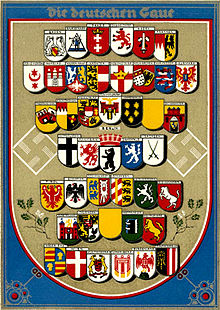Reichsgau
The Reichsgaue were an attempt to resolve the administrative chaos resulting from the mutually overlapping jurisdictions and different boundaries of the NSDAP Party Gaue, placed under a Party Gauleiter, and the federal states, under a Reichsstatthalter responsible to the Ministry of the Interior (in the Prussian provinces, the equivalent post was that of Oberpräsident).
Interior Minister Wilhelm Frick had long desired to streamline the German administration, and the Reichsgaue were the result: the borders of party Gaue and those of the federal states were to be identical, and the party Gauleiter also occupied the post of Reichsstatthalter.
Rival interests and the influence the Gauleiter wielded with Hitler prevented any reform from being undertaken in the "Old Reich" (German: Altreich), which meant Germany in its borders of 1937 before the annexation of other territories like Austria, the Sudetenland, and Bohemia, and the Reichsgau scheme was therefore implemented only in newly-acquired territories.
The conservative wing of the German resistance to Nazism, namely Ludwig Beck and Carl Goerdeler, had planned to divide all of Germany (in the borders of 1938 plus the pre-1918 Prussian lands) after a successful takeover of the government into Reichsgaue, modeled after the counties in the UK and the provinces of Prussia.
According to Goerdelers 1941 memorandum Das Ziel («The Goal»), every Gau should have been self-administered by a Gau Landtag and overseen by a Oberpräsident (similar to a British lord-lieutenant).



